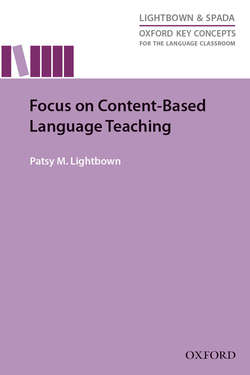Читать книгу Focus on Content-Based Language Teaching - Patsy M. Lightbown - Страница 5
На сайте Литреса книга снята с продажи.
Introduction
ОглавлениеIn schools all over the world, students are taught their academic subjects – mathematics, science, history – in a language that is not the one they learned at home. They are challenged to understand difficult new ideas, ask and answer questions, present reports, and sometimes take examinations in a language they are still learning. More and more teachers find that they need to be prepared to work with language learners in their classes.
Educational approaches that combine instruction in a new language and academic subjects are referred to as content-based language teaching (CBLT). CBLT is a major part of the education of millions of children, and that number is growing. For children who are immigrants or members of a minority-language group, going to school means learning a new language. For members of majority-language groups, proficiency in another language is seen as a way to enhance personal and professional opportunities. For both these groups, CBLT combines language learning with ongoing academic work.
The purpose of this book is to explore the possibilities and challenges of CBLT in primary and secondary schools in a variety of settings. The book will be of interest to educators who are new to this approach and to experienced CBLT teachers who want to add to their professional knowledge about the origins, achievements, and continuing evolution of this way of teaching.
Chapter 1 provides descriptions of some of the many different ways that CBLT has been implemented for students who have a variety of options and goals in learning a new language.
In Chapter 2 we will look at some findings and implications of research in education, psychology, and language acquisition that help to explain the principles underlying CBLT.
In Chapters 3 and 4, the focus will be on research that has been carried out in CBLT classrooms. In Chapter 3, we will review studies done with young learners – from pre-kindergarten through about age 11. In Chapter 4, research with 12- to 18-year old learners will be reviewed. In these chapters, we will examine research in both foreign-language and second-language (L2) settings, in schools where students receive all of their instruction in the new language and others where some academic subjects are taught in the students’ first language (L1). The emphasis will be on relationships between what happens in classrooms and students’ learning outcomes, in terms of both academic content knowledge and second language development.
Chapter 5 will provide a summary of the most important points covered in detail in the earlier chapters.
Some of the studies we review will be designated as Spotlight Studies. These are important not only because of what the researchers discovered, but also because the studies exemplify the different approaches that are used to look for answers to questions about how educational programs can most effectively help students learn both academic content and a new language at the same time. Each chapter will include Classroom Snapshots – brief descriptions or transcriptions of interaction between teachers and students or between students and their peers in CBLT classes. Naturally, brief snapshots cannot capture a whole program of instruction or even a single lesson. Nevertheless, they provide concrete examples of how teachers and learners cope with the opportunities and challenges of CBLT and allow us to connect our discussion of general principles to moments in real classrooms. In addition, each chapter will include some Activities that invite you to deepen your understanding of underlying questions, assumptions, or research findings through personal reflection, interacting with language learners and teachers, or doing some research of your own.
An annotated list of Suggestions for Further Reading will highlight some of the many excellent sources that have been consulted in the writing of this book. The Glossary provides definitions of terms that may either be unfamiliar to some readers or have a special meaning in the context of CBLT. These terms will be in bold print the first time they appear in the text, and the Index will allow you to find other mentions of them. The References section will provide complete information for all the sources that are cited in the chapters.
It is no exaggeration to say that there are thousands of articles, reports, and books on CBLT. A new journal devoted exclusively to research in this area has just been launched. This book is intended to introduce some of the findings and recommendations that have arisen from the research and from the experience of teachers and students over the years.
